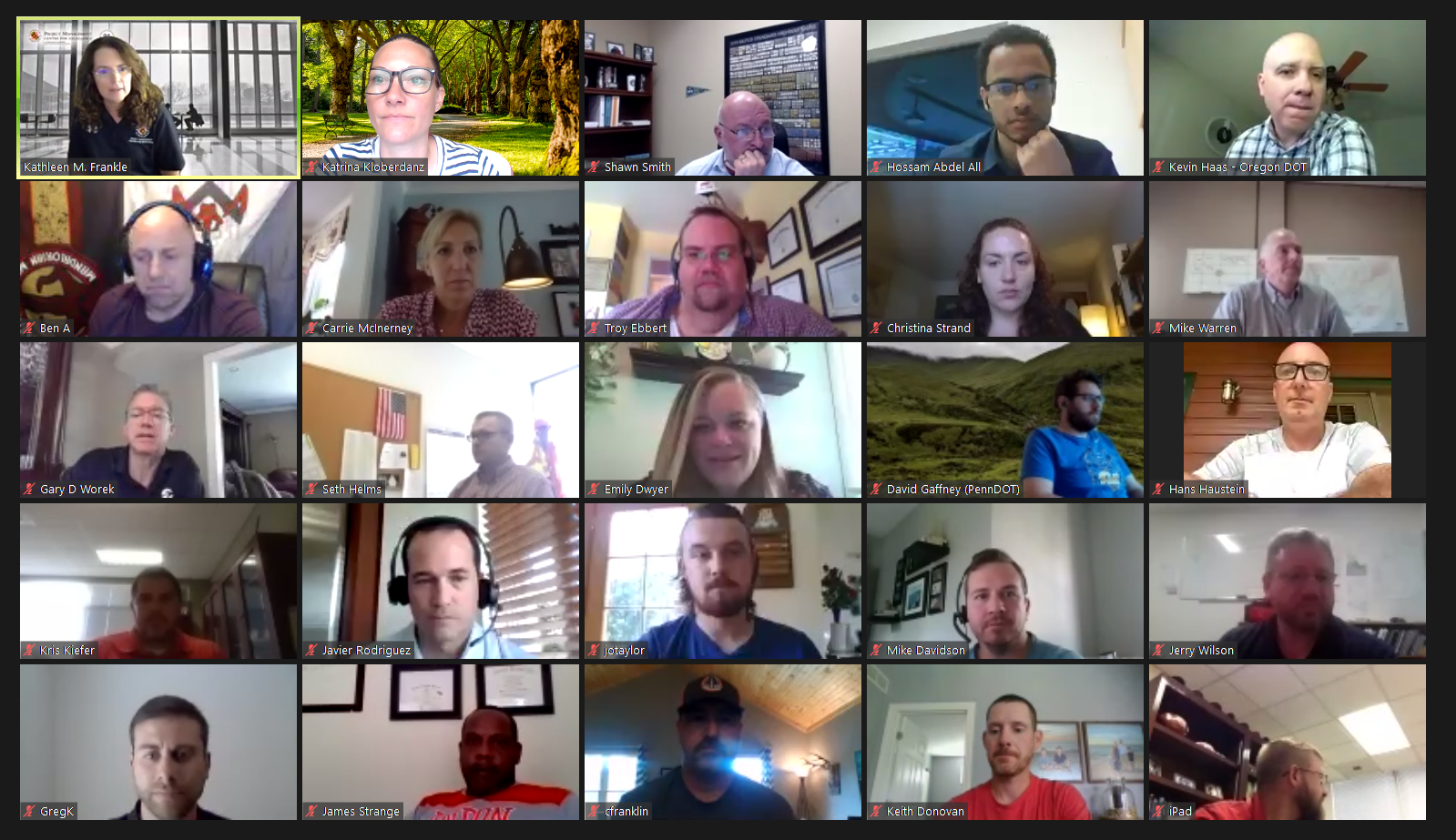INTRODUCTION
The coronavirus pandemic has been the motivation to quickly move campus courses online. The Project Management Center of Excellence has long been offering online classes in a variety of formats initially at the graduate level, but increasingly at the undergraduate level as well. Many faculty on campus have traditionally resisted teaching their classes online. However, the convulsive shift caused by the pandemic has given us a new opportunity to assess which aspects of teleworking and moving classes online have worked pretty well. What can we learn from this experience and what might the future look like?
When we think about Academia in a Virtual Environment there are certainly many functions in addition to instruction such as research, laboratory work in many disciplines, advising, mentoring, and many extracurricular activities. Some of these can work well virtually, for example, we at Maryland already do centralized academic advisement that was moved all online, and is working quite well, but other functions are more of a challenge. This article is focused on course instruction.
Our team thinks that we have a tremendous opportunity to significantly improve education and of course, if we can do that, we improve the student experience. In this article I am going to discuss a variety of things but there are basically three key ideas. One is to design our courses to be resilient, second is to utilize blended and active learning principles in course design, and the third is, if we do that, we can have the same course content and use it either online or on campus.
So the first point here is disruptions happen, and of course, we’re in this horrible pandemic right now, but if you think about it, we often have interruptions. Typically weather events, sometimes travel events, and sometimes it’s either personal health or family issues that cause a major disruption in what was planned. So the point I want to make is, let’s be smart and let’s design our courses to be resilient, meaning that they may be taught on campus or online and the shift is seamless.
So there are a couple basics to do this. The first is that course design is not either/or, but and/also. In other words, if we’re smart about it, we can design a course that’s equally effective in either environment, teaching on campus or teaching online. We want to embrace the multiple learning styles that our students have, and we want to be able to do this so that again, the course can be offered in either situation. The third thing that we want to pay attention to is to take advantage of what technology can do for us. Let’s let technology enhance the teacher and student experience. Our learning management systems often are not fully utilized, and yet we really need to utilize them if we want to achieve our goals. There are also some very advanced video conferencing systems (we use Zoom at UMD) that enable us to do our jobs well.
THE LEARNER
Let’s first take a minute and think about the learner, our students, and how they learn best? We’re used to thinking in terms of the pure cognitive style, but if we pay attention to education, we need to be thinking about their learning style and what are their different preferences? There’s a lot of research that lists a variety of differences in how people think and process information, but basically they get lumped into three categories: visual learners, auditory learners, and kinesthetic learners meaning that they like motion/doing.
Using the principles of Universal Design for Learning (UDL) we must design our courses to meet the needs of each of the students. If you’re not familiar with UDL, it is basically a framework for learning that is based on cognitive and learning science and really focuses on optimizing learning for all students. So if you’re using UDL, you’re definitely complying with all the rules for accessibility, so students with disabilities are going to be well served by this. UDL is a really interesting and powerful framework that’s going to make learning better for all students.
BLENDED CLASSES & ACTIVE LEARNING
When we sit down to design a course, you should develop a blended classroom. In simple terms, it’s the best aspects of both online and on-campus learning. What’s the big deal? Quite simply, blended learning is the most effective teaching format[1]. Blended courses are designed to put all of the course material on a learning management system (LMS), at Maryland we use Canvas, for the student to access and prepare prior to meeting with the instructor. This means that videos of the lectures, slide decks, reading and homework assignments, knowledge checks, quizzes, schedules, and references are available to the student online.
Class time is used for discussion, work groups, case studies or projects to apply the concepts all under the supervision of the teacher. Of course, we want to do a lot of project-based learning where teams of small groups, three to five students, get together to work on different problems and report out to the rest of the class. The teacher is no longer the “sage-on-the-stage” but is now a facilitator. The lectures are now a deck of short videos watched before class.
When the course is an active learning environment, students get more engaged, and when they’re more engaged, they’re more focused. Students learn from each other, as much as they do from the teacher. I think it was Stephen Leacock at one time said, “If you’re creating a new university, first build dormitories, and if there’s any money left over hire a teacher.” Recognizing that the students really do learn from each other quite a lot. At Maryland, they’re designing new buildings with what they call “Terp Classrooms.” These classrooms are fully technology enabled and the seating is round tables with six or eight students. The tables can be configured to do whatever exercise the teacher wants to do. These are not your typical classroom lecture halls.
That’s a nice idea for campus, but what’s that got to do with online? Well, guess what? Best practices for teaching online are the same as the best practices for teaching on campus where the student prepares before coming to the class and in the case of online, the class is a video conference.
USING TECHNOLOGY
Advanced video conferencing platforms have features that effectively simulate an actual classroom. At Maryland, we principally use Zoom, but WebEx and other platforms are also available. Zoom has excellent real time video and audio functionality and we can see the participants live. There is a polling function so the instructor can take quick surveys to engage the students and gather their responses. This function increases student engagement which is one of the keys to effective virtual learning. And, there is a breakout room function so the class can be subdivided into teams and work together on assignments. The teacher can go in every breakout room and provide supervision or guidance as needed. There is a chat function and a share screen function that allows participants to show their work (slides, videos, spreadsheets etc). The point I want to make is that advanced video conferencing systems allow you to virtually function very much like an in-person classroom.

One of the key points we like to make in teaching online and on campus is to run knowledge checks before class. Use your LMS to give short quizzes and the students will have a real motivation to make sure they’ve done their homework before they come to class.
In addition to putting all course content into Canvas as previously mentioned, the LMS system helps us to: measure our progress against course learning outcomes, screen for plagiarism using Turnitin, use grading rubrics to establish consistency and facilitate rapid grading and feedback of written assignments, implement quizzes and tests using multiple choice, true/false, or multiple answer techniques self-grade (the grades are exported to the grade book) and analyze grades so the teacher knows how the student is doing in the course. Honorlock is used for exam proctoring.
One thing we really recommend, no matter what learning management system you use, don’t let individual faculty members just create their courses. Use a standardized template for the department so all courses have a consistent look and feel. Students really like to have the same experience when they open up the course content area so they know how to navigate through the material.
We deliberately design the online experience to ensure that it is very engaging for the student. The students get to know each other, and they get to know the professor. Like all of you, at the end of the semester, I always say, “Let’s talk a little bit about your educational experience this semester. What was this class like for you?” One student said, “Well sir, I’ve spent more time talking to you in this online course than I would have if I sat in the front row of your lecture hall,” and until that student actually said that I never actually thought about it. We have weekly video conferences and the students are indeed quite interactive. Ultimately, the students end up spending more one-on-one time with you than they would in most campus classroom settings. Thus, it is our experience that online blended courses actually work extremely well, but the key is that the faculty has to engage the students.
The final point I would like to share is that the time it takes to prepare and organize all of the course materials, including the videos, is an upfront investment that pays off significantly in a more effective class and much less time required for the instructor during delivery of the class each term. The course can be used repeatedly and only updated as content change is desired.
[1] The 2019 edX Impact Report.
This article appeared in PM World Journal, Vol. IX, Issue VIII, August 2020.

John Cable, Director, Project Management Center for Excellence, University of Maryland
How to cite this article: Cable, J. H. (2020). Converting to Online Teaching: A Series of short guidance articles for educators and institutions – The Future of Academia in a Virtual Environment, PM World Journal, Vol. IX, Issue VIII, August.
Posted by Kathy Frankle on August 5, 2020

 Data Analytics for the Project Manager
Data Analytics for the Project Manager